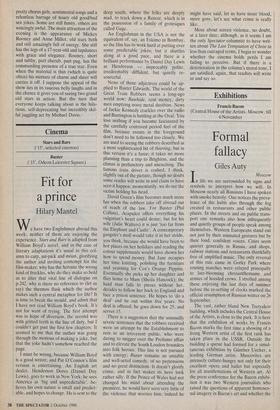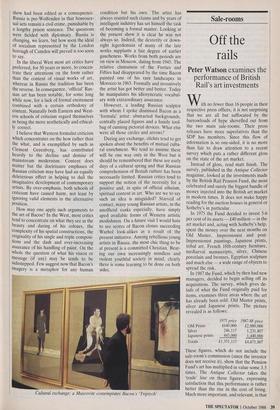Exhibitions
Francis Bacon (Central House of the Artists, Moscow, till 6 November
Formal fallacy
Giles Auty
IMoscow
n life we are surrounded by signs and symbols to interpret how we will. In Moscow nearly all Russians I have spoken with smoke heavily. One notices the preva- lence of the habit also through the fog created in restaurants and other public places. In the streets and on public trans- port one remarks also how infrequently and quietly groups of people speak among themselves. Western Europeans stand out not just by their animated gestures but by their loud, confident voices. Cities seem quieter generally in Russia, and shops, railway stations and restaurants thankfully free of amplified music. The only reversal of this rule came in Gorky Park where rousing marches were relayed principally to late-blooming chrysanthemums and armies of hooded crows. I strolled among these enjoying the last days of summer before the re-setting of clocks marked the official resumption of Russian winter on 26 September.
The vast, rather bland New Tretyakov building, which includes the Central House of the Artists, is close to the park. It is here that the exhibition of works by Francis Bacon marks the first time a showing of a living Western artist of the first rank has taken place in the USSR. Outside the building a queue had formed for a simul- taneous exhibition by Gunther Uecker, a leading German artist. Muscovites are intensely culture-hungry not only for their excellent opera and ballet but especially for all manifestations of Western art. At the press conference for the Bacon exhibi- tion it was two Western journalists who raised the questions of apparent homosex- ual imagery in Bacon's art and whether the show had been edited as a consequence. Russia is pre-Wolfenden in that homosex- ual acts remain a civil crime, punishable by a lengthy prison sentence. The questions were fielded with diplomacy. Russia is changing, we learn, but how soon the ideal of socialism represented by the London borough of Camden will prevail is too soon to say.
In the liberal West most art critics have preferred, for 50 years or more, to concen- trate their attentions on the form rather than the content of visual works of art, whereas in Russia the tradition has been the reverse. In consequence, 'official' Rus- sian art has been notable, for some long while now, for a lack of formal excitement combined with a certain orthodoxy of content. Naturally both Eastern and West- ern schools of criticism regard themselves as being the more aesthetically and ethical- ly correct.
I believe that Western formalist criticism which concentrates on the how rather than the what, and is exemplified by such as Clement Greenberg, has contributed heavily to the decline and demise of mainstream modernism. Content does matter but the doctrinaire emphases of Russian criticism may have had an equally deleterious effect in helping to dull the imaginative development of contemporary artists. By over-emphasis, both schools of criticism have caused harm, not least by ignoring valid elements in the alternative position.
How may one apply such arguments to the art of Bacon? In the West, most critics tend to concentrate on what they see as the beauty and daring of his colours, the complexity of his spatial constructions, the originality of his single and triple composi- tions and the dash and ever-increasing assurance of his handling of paint. On the whole the question of what his vision or message (if any) may be tends to be sidestepped. Few suggest now that Bacon's imagery is a metaphor for any human condition but his own. The artist has always resisted such claims and by years of intelligent indtistry has set himself the task of becoming a formal master. Looking at the present show it is clear he was not always so. Indeed, the dexterity or down- right legerdemain of many of the late works supplants a fair degree of earlier gaucheness. Works from both periods are on view in Moscow, dating from 1945. The relative clumsiness of the Forties and Fifties had disappeared by the time Bacon painted one of his rare landscapes in Morocco in 1963. Formally and inventively the artist has got better and better. Today he manipulates his idiosyncratic vocabul- ary with extraordinary assurance.
However, a leading Russian sculptor with whom I spoke dismissed Bacon as a `formula' artist: abstracted backgrounds, centrally placed figures and a handy tool- bag of cunning pictorial devices. What else were all those circles and arrows?
During any exchange, clichés tend to get spoken about the benefits of mutual cultu- ral enrichment. We tend to assume these will be one way only in the West but it should be remembered that these are early days of a cultural spring and that Russian comprehension of British culture has been necessarily limited. Russian critics tend to support the notion of the necessity for a positive and, in spite of official atheism, spiritual content in art. Who are we to say such an idea is misguided? Starved of contact, many young Russian artists, in the unofficial ranks especially, have simply aped available forms of Western artistic modishness. On a future visit I would hate to see scores of Bacon clones succeeding Warhol look-alikes as a result of the present initiative. Among rebellious young artists in Russia, the most chic thing to be at present is a committed Christian. Bear- ing our own increasingly mindless and violent youthful society in mind, clearly there is some learning to be done on both sides.
Cultural exchange: a Muscovite contemplates Bacon's 'Triptych'



































































 Previous page
Previous page